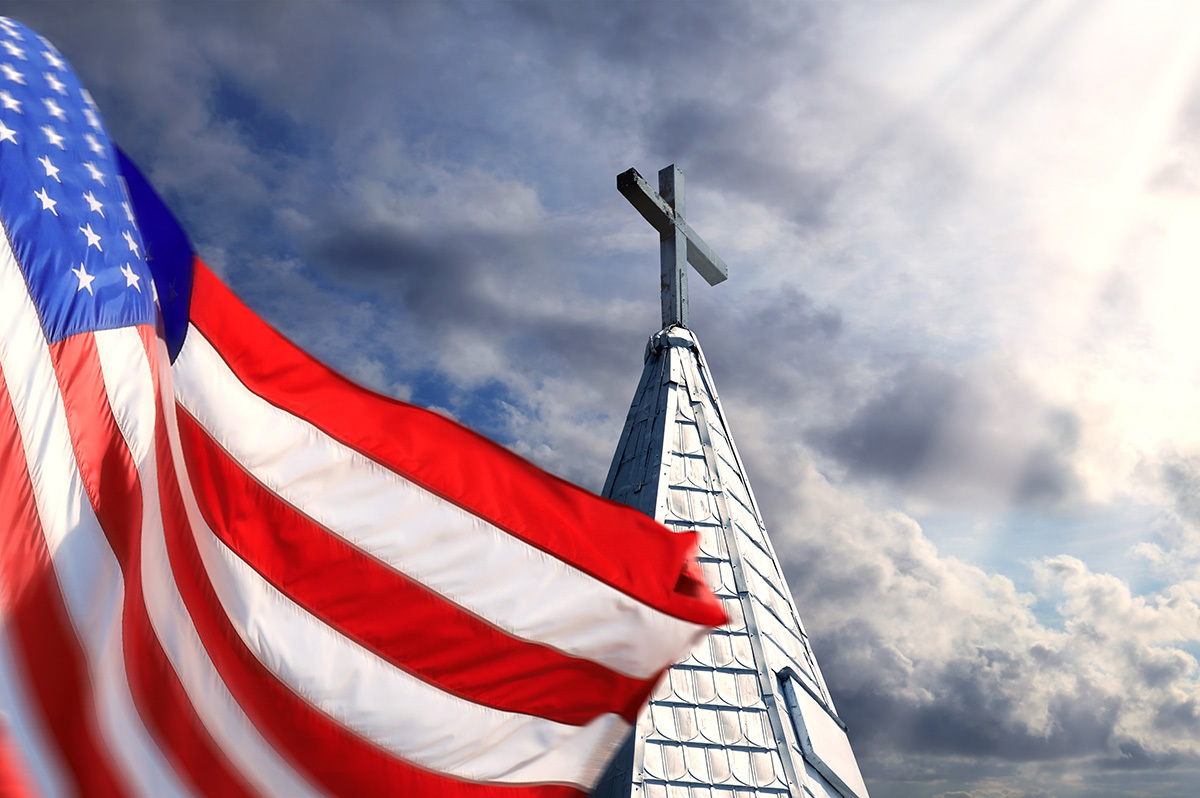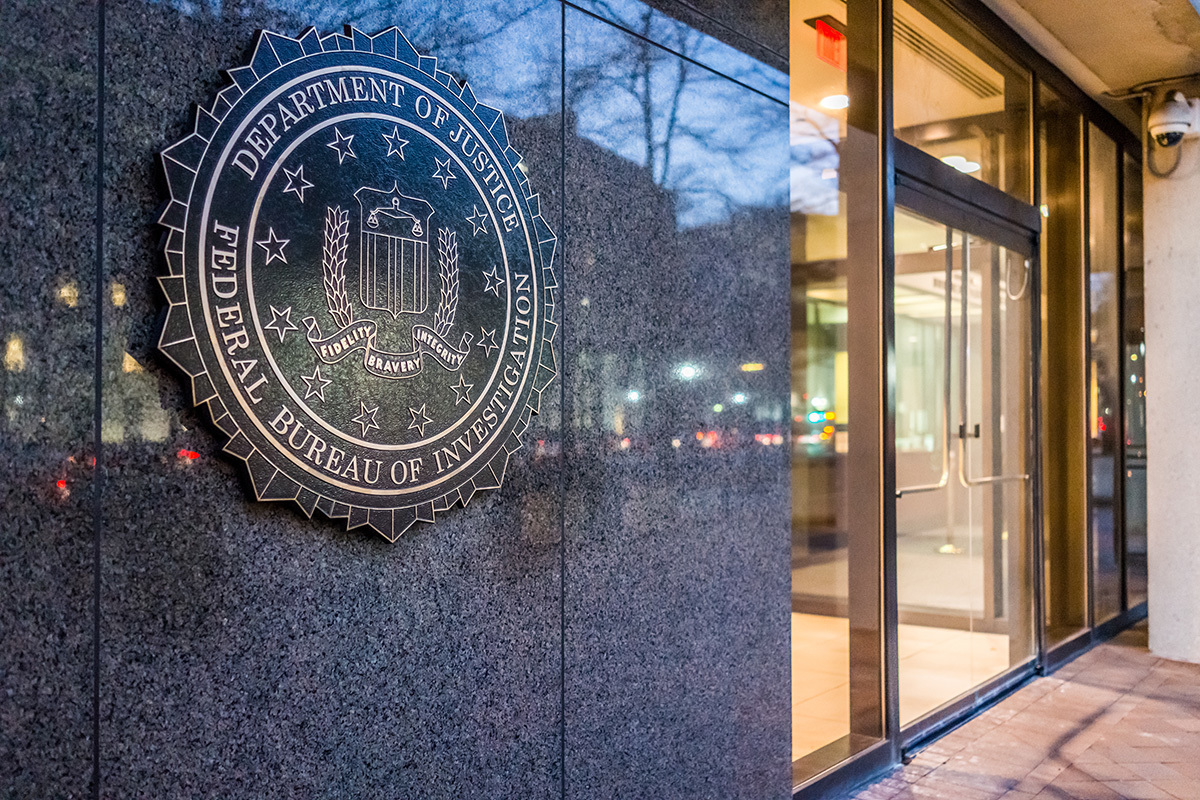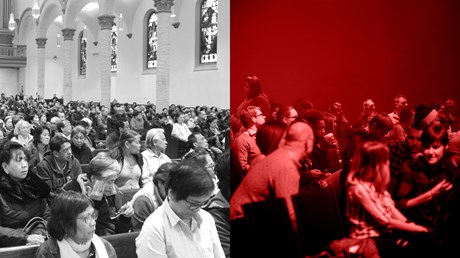Search Results for religion
Links
A ministry to baptist preachers and churches
|
Christianheadlines.com
|
Articles
Videos
News
Temple Baptist Church - 4-28-2024Romans 10:1-17? Introduction:? A.? Verse 3 says, “They being ignorant.”? Ignorant?? Lacking knowledge or? comprehension? of the thing specified.? The implication of the word “being” is to ignore.? In the Bible, we find two kinds of ignorance:? 1.? Ignorance as a result of not hearing or being taught.? Amos 8:11-12? Behold, the days come, saith the Lord GOD, that I will send a famine in the land, not a famine of bread, nor a thirst for water, but of hearing the words of the LORD:? (12)? And they shall wander from sea to sea, and from the north even to the east, they shall run to and fro to seek the word of the LORD, and shall not find it.? 2.? Willful ignorance as a result of rejecting what is heard or taught.? Hosea 4:6? My people are destroyed for lack of knowledge: because thou hast rejected knowledge, I will also reject thee, that thou shalt be no priest to me: seeing thou hast forgotten the law of thy God, I will also forget thy children.? 3.? As your pastor, it is my responsibility that, if you remain ignorant, it will have to be willful ignorance!? 4.? Israel was Ignorant, but their ignorance was willful!? Look at the preceding verses found in chapter 9:32-33.? “As it is written!”? THEY HAD THE WORD OF GOD!? THEY KNEW THE WORD OF GOD!? THEY DISREGUARDED THE WORD OF GOD!? ? 5.? SO IT IS IN OUR DAY AS WE HAVE THE WORD OF GOD!? The problem today is the same as the problem then.? ? Hosea 4:6? My people are destroyed for lack of knowledge:? because thou hast rejected knowledge, I will also reject thee!? B.? One of the age-old problems (and one that remains in our day) is that people are ignorant of what it takes to get to heaven.? Most religions along with so-called Christian denominations add works to faith in one degree or another.? C.? Self-righteousness in Salvation.? Salvation through personal merit or a mixture of personal merit and faith.? The Bible is perfectly clear about the separation of faith and works.? Romans 11:5-6? Even so then at this present time also there is a remnant according to the election of grace.? (6)? And if by grace, then is it no more of works: otherwise grace is no more grace. But if it be of works, then is it no more grace: otherwise work is no more work.? Ephesians 2:8-9? For by grace are ye saved through faith; and that not of yourselves: it is the gift of God:? (9)? Not of works, lest any man should boast.? Acts 4:11-12? This is the stone which was set at nought of you builders, which is become the head of the corner.? (12)? Neither is there salvation in any other: for there is none other name under heaven given among men, whereby we must be saved.? ? 1.? Self-righteousness manifests itself in those who believe that they are good enough to go to heaven through personal merit.? 2.? Self-righteousness manifests itself in those who believe that they are good enough to maintain their salvation through personal merit.? ? 3.? Both doctrines are heretical!? D.? In our text, we find why Israel turned from their Messiah, Christ Jesus.? Israel, who had the truth of God's Word and the Covenants, turned from the faith of their father, Abraham, to the wickedness of self-righteousness.? ? 1.? In the 400 hundred silent years that preceded the coming of Christ (around 100 B.C.) between Malachi and Matthew, two main branches of Judaism came into dominance: 1)? The Sadducees who upheld the Written Law? 2)? The Pharisees who upheld the Oral Law.? ? 2.? ? Galatians 6:12-14? As many as desire to make a fair shew in the flesh, they constrain you to be circumcised; only lest they should suffer persecution for the cross of Christ. ? (13)? For neither they themselves who are circumcised keep the law; but desire to have you circumcised, that they may glory in your flesh. ? (14)? But God forbid that I should glory, save in the cross of our Lord Jesus Christ, by whom the world is crucified unto me, and I unto the world.? ? 3.? They had the unbiblical perspective that they had “arrived” spiritually through their outward appearance and separation from the world.? This attitude resulted in exclusion!? E.? The Pharisees were separatists and, unfortunately, they eventually began to rely upon their system of “do's and don'ts” for righteousness with God instead of becoming obedient to God's righteousness.? The Lord rebuked them for making clean the outer appearance while the inner man was full of dead men's bones and rottenness.? ? In Matthew 5:20, our Lord said, “Except your righteousness shall exceed the righteousness of the scribes and Pharisees, ye shall in no case enter into the kingdom of heaven.”? F.? The problem still exists today.? Separatism and Phariseeism are not the same.? God command us to be separate but, if not watchful, the same problem arises again.? I once saw on a sign this quote, “People are like fish: you catch them but let God clean them.”? ? G.? Paul's desire and prayer for Israel was that they would recognize who Jesus Christ was and turn to Him for salvation.? Israel had “zeal” for God but not according to knowledge.? Spirit is good but leaves one lost without truth.? I want to look at a few things in this text.? 1.? Ignorance of God's Righteousness.? Vs. 3.? “not according to knowledge…ignorant of God's righteousness”? ? Psalms 71:19? Thy righteousness also, O God, is very high, who hast done great things: O God, who is like unto thee!? a.? Ignorance is not necessarily a bad word as it means that one has not learned.? In Romans 10, I believe that the ignorance mentioned was willful.? ? b.? Israel was familiar with the Old Testament and especially the Pentateuch.? One of the greatest of Old Testament truths found in these first 5 books was that of the holiness of God.? Mt. Sinai should have left a lasting impression upon the nation of Israel as God thundered from a mountain that was on fire.? ? ? c.? Israel's ignorance was willful!? The world's ignorance is willful!? The world of today tries to bring God down to man's level and man up to God's level.? 2.? Impeccability of God's Righteousness.? Vs. 3.? “God's righteousness”? The Bible declares that God dwells in a light that no man can approach unto.? He is impeccably holy.? He is immutably holy.? He said, “I am the Lord, I change not.”? 1 Timothy 6:15-16? Which in his times he shall shew, who is the blessed and only Potentate, the King of kings, and Lord of lords;? (16)? Who only hath immortality, dwelling in the light which no man can approach unto; whom no man hath seen, nor can see: to whom be honour and power everlasting. Amen.? a.? Salvation must always be by grace through faith because God demands absolute perfect holiness, and He alone is impeccably holy.? b.? Acceptance of God's righteousness is the rejection of personal righteousness.? 3. Impossibility of God's Righteousness.? Vs. 3.? “going about to establish their own righteousness.”? ? Ecclsiastes 7:20? For there is not a just man upon earth, that doeth good, and sinneth not.1 John 1:8-10? If we say that we have no sin, we deceive ourselves, and the truth is not in us.? (9)? If we confess our sins, he is faithful and just to forgive us our sins, and to cleanse us from all unrighteousness.? (10)? If we say that we have not sinned, we make him a liar, and his word is not in us.? a.? One fact that every saved person understands is that of personal sinfulness.? There are those who believe that they are sinless, but they are deceived and lost.? ? b.? No conviction of sinfulness means there is no Holy Spirit there to convict.? Men everywhere are trying to be right with God with what they do instead of what He did.? 4.? Insubordination to God's Righteousness.? Vs. 3.? “have not submitted themselves”? ? Galatians 3:1-3? O foolish Galatians, who hath bewitched you, that ye should not obey the truth, before whose eyes Jesus Christ hath been evidently set forth, crucified among you?? (2)? This only would I learn of you, Received ye the Spirit by the works of the law, or by the hearing of faith?? (3)? Are ye so foolish? having begun in the Spirit, are ye now made perfect by the flesh?? ? a.? Along with recognition of God's righteousness, one must become obedient to the holiness of God's demand: obedience to the gospel.? Vs. 16.? ? b.? Romans 1 shows the progression of the knowledge of God rejected:? 1)? When they knew God, they glorified Him not as God - God gave them up)? 2)? They changed the truth of God into a lie - God gave them up again? 3)? They did not like to retain God in their minds - God gave them over to a reprobate mind.? 5.? Imputation of God's Righteousness.? Vs. 4.? “For Christ is the end of the law for righteousness to every one that believeth.”? Salvation is a result of God's righteousness being imputed to the believer through propitiation and faith.? ? 2 Corinthians 5:21? For he hath made him to be sin for us, who knew no sin; that we might be made the righteousness of God in him.? Jude 24-25? Now unto him that is able to keep you from falling, and to present you faultless before the presence of his glory with exceeding joy,? (25)? To the only wise God our Saviour, be glory and majesty, dominion and power, both now and ever. Amen.? ? “Dressed in His righteousness alone; faultless to stand before the throne.”? “When He sees me, He sees the blood of the Lamb; He sees me as worthy and not as I AM!”? 6.? Invitation of God's Righteousness.? Vs. 13.? “For whosoever shall call upon the name of the Lord shall be saved.”? ? ? ? “Whosoever” covers it all!? Come to Jesus Christ with your bankrupt life and He will impute His righteousness to you.
|
 Southern Baptists, while generally conservative in their political ideology, maintain a firm commitment to religious liberty for all Americans and support a government that does not favor any specific religion, according to a Lifeway Research study. Southern Baptists, while generally conservative in their political ideology, maintain a firm commitment to religious liberty for all Americans and support a government that does not favor any specific religion, according to a Lifeway Research study. |
The world is realizing anew that our faith has tangible benefits. This is an opportunity for the gospel.
 As Christianity continues to decline in the West, the broader world has begun to notice something’s missing. There seems to be a growing awareness that—for all the scandals and failings of the church—the loss of a Christian culture leaves us all worse off, and that there are benefits to being a Christian and to living in a Christian society.For example, Derek Thompson recently wrote in The Atlantic about the loss of community that comes with declining church attendance. “Maybe religion, for all of its faults, works a bit like a retaining wall,” he concluded, “hold[ing] back the destabilizing pressure of American hyper-individualism, which threatens to swell and spill over in its absence.”Likewise, Harvard scholar Tyler J. VanderWeele has extensively researched the benefits of participation in religious services, finding that it leads to improved mental and physical health, happiness, and sense of meaning. Statistically, going to church regularly will help you flourish as a human being. As Brad Wilcox, a professor at the University of Virginia, has shown, regular church attendance even correlates with a more satisfying sex life!And then you have those like former atheist Ayaan Hirsi Ali who explain their conversion to Christianity at least partly as a response to the decay of the contemporary world, a world threatened by “woke ideology,” “global Islam,” and authoritarianism. “The only credible answer, I believe, lies in our desire to uphold the legacy of the Judeo-Christian tradition,” Hirsi Ali said in an essay announcing her new faith. Famous atheist Richard Dawkins objected to Hirsi Ali’s conversion yet seems to ...Continue reading... As Christianity continues to decline in the West, the broader world has begun to notice something’s missing. There seems to be a growing awareness that—for all the scandals and failings of the church—the loss of a Christian culture leaves us all worse off, and that there are benefits to being a Christian and to living in a Christian society.For example, Derek Thompson recently wrote in The Atlantic about the loss of community that comes with declining church attendance. “Maybe religion, for all of its faults, works a bit like a retaining wall,” he concluded, “hold[ing] back the destabilizing pressure of American hyper-individualism, which threatens to swell and spill over in its absence.”Likewise, Harvard scholar Tyler J. VanderWeele has extensively researched the benefits of participation in religious services, finding that it leads to improved mental and physical health, happiness, and sense of meaning. Statistically, going to church regularly will help you flourish as a human being. As Brad Wilcox, a professor at the University of Virginia, has shown, regular church attendance even correlates with a more satisfying sex life!And then you have those like former atheist Ayaan Hirsi Ali who explain their conversion to Christianity at least partly as a response to the decay of the contemporary world, a world threatened by “woke ideology,” “global Islam,” and authoritarianism. “The only credible answer, I believe, lies in our desire to uphold the legacy of the Judeo-Christian tradition,” Hirsi Ali said in an essay announcing her new faith. Famous atheist Richard Dawkins objected to Hirsi Ali’s conversion yet seems to ...Continue reading... |
 The U.S. Department of Justice's Inspector General maintains that the FBI did not commit any wrongdoing or demonstrate hostility toward religion by circulating an internal document warning about connections between "racially or ethnically motivated violent extremists" and "radical-traditionalist Catholic ideology."? The U.S. Department of Justice's Inspector General maintains that the FBI did not commit any wrongdoing or demonstrate hostility toward religion by circulating an internal document warning about connections between "racially or ethnically motivated violent extremists" and "radical-traditionalist Catholic ideology."? |
Studies find that while less than a third of Americans trust church leaders, 90 percent of Filipinos do.
 While less than a third of Americans rate clergy as highly honest and ethical, across the globe in the Philippines, 91 percent of the public trusts religious leaders, according to EON Group’s 2021 Philippine Trust Index. Respondents of the survey ranked pastors as the most trusted leaders in Filipino society, compared to a Gallup poll that found clergy in the US ranked lower than 10 other professions, including chiropractors and police officers.“When people outside of church find out I’m a pastor, their demeanor changes out of respect,” said Aldrin Peñamora, director of the Philippine Council of Evangelical Churches’ Justice, Peace, and Reconciliation Commission. Some people even ask him for prayer.The disconnect is rooted in cultural differences, religion’s role in society, as well as the impact of church scandals. Still, pastors from both countries noted the importance of having pastors engage with their congregations and local communities to build trust.Drivers of trust in the Filipino churchIn the Philippines, Catholics make up 80 percent of the population, while evangelicals make up about 3 percent. Catholicism came to the Philippines through Spanish colonialism and stuck as Filipinos made their faith their own. Today, the Catholic faith has become a cultural attribute of Filipino life.The high view of church leaders also reflects traditional Filipino values, said Peñamora: “Filipino culture values respecting the elderly, which spills over to their submission to people in authority, including religious authority.”In the Philippines, older people are considered wise, and they provide a sense of order and direction to the life of the community, Peñamora ...Continue reading... While less than a third of Americans rate clergy as highly honest and ethical, across the globe in the Philippines, 91 percent of the public trusts religious leaders, according to EON Group’s 2021 Philippine Trust Index. Respondents of the survey ranked pastors as the most trusted leaders in Filipino society, compared to a Gallup poll that found clergy in the US ranked lower than 10 other professions, including chiropractors and police officers.“When people outside of church find out I’m a pastor, their demeanor changes out of respect,” said Aldrin Peñamora, director of the Philippine Council of Evangelical Churches’ Justice, Peace, and Reconciliation Commission. Some people even ask him for prayer.The disconnect is rooted in cultural differences, religion’s role in society, as well as the impact of church scandals. Still, pastors from both countries noted the importance of having pastors engage with their congregations and local communities to build trust.Drivers of trust in the Filipino churchIn the Philippines, Catholics make up 80 percent of the population, while evangelicals make up about 3 percent. Catholicism came to the Philippines through Spanish colonialism and stuck as Filipinos made their faith their own. Today, the Catholic faith has become a cultural attribute of Filipino life.The high view of church leaders also reflects traditional Filipino values, said Peñamora: “Filipino culture values respecting the elderly, which spills over to their submission to people in authority, including religious authority.”In the Philippines, older people are considered wise, and they provide a sense of order and direction to the life of the community, Peñamora ...Continue reading... |



 Links
Links  Articles
Articles  Blogs
Blogs  Videos
Videos  News
News  Colors
Colors 

 New links
New links







![AIBC Live: Why does God allow so many religions to exist? [Mat 13] 31/12/2023](https://img.youtube.com/vi/0IBd03z9KD4/1.jpg)





